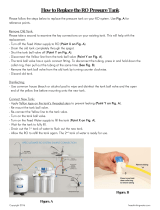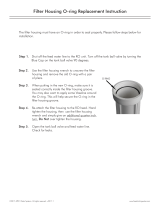
2
Introduction
About Your Reverse Osmosis System
Thank you for your purchase of the Olympia Water Systems Reverse Osmosis System.
This 5-Stage Reverse Osmosis System was designed and tested to provide high quality drink-
ing water. The following are brief descriptions of each of the 5 stages in this system.
Caution
Do not use this system with water that is microbiologically unsafe or of unknown quality without adquete pretreatment. This
system is for use on potable water only.
Filter Stages
Cartridge Filters Model Filter Description Service Life
Stage 1
5 Micron Sediment Filter
OROS-PRESF Polypropylene lter for removal of
sand, silt, dirt and rust particles.
6 Months
Stage 2
5 Micron Carbon Filter
OROS-PRECB Coconut shell carbon block for
removing volatile organic carbon
compounds, insecticides/pesticides
and chemicals.
*
6 Months
Stage 3
5 Micron Carbon Filter
OROS-PRECB Coconut shell carbon block for
removing volatile organic carbon
compounds, insecticides/pesticides
and chemicals.*
6 Months
Stage 4
RO Membrane
OROS-ROM50
(50 GPD Membrane)
OROS-ROM80
(80 GPD Membrane)
For removing the following contam-
inants in your water: Arsenic, Barium,
Cadmium, Chromium (Hexavelent),
Chromium (Trivalent), Copper, Turbid-
ity, Fluoride, Lead, Radium 226/228,
Selenium* and TDS.
2-3 Years
Stage 5
Post Carbon Filter
OROS-POST Coconut shell post carbon lter for
chlorine, taste and odor reduction.
2,500 Gallons
(9,463 Liters)
*These claims are based on manufacturer testing. These claims are not certied by NSF.
Replacement Filters
Olympia Water Systems oers replacement lters for both the OROS-50 and OROS-80 Re-
verse Osmosis water ltration systems. For purchasing information for replacement lters,
please visit our website at www.olympialtration.com.


































